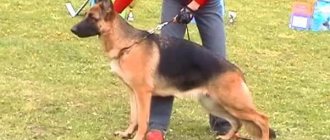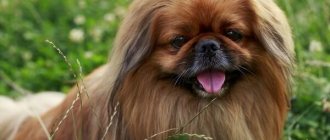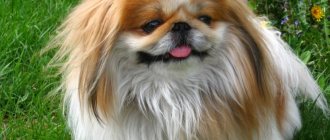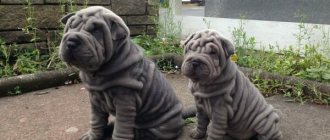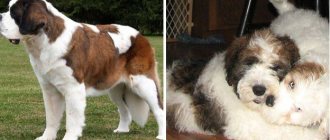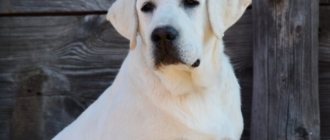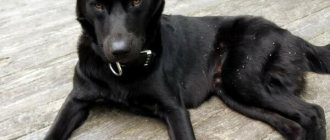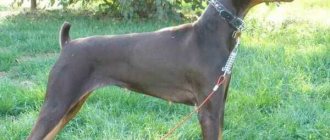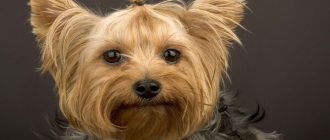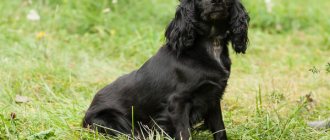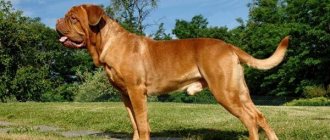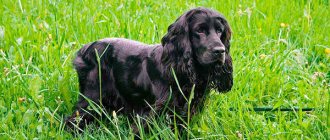The Pekingese is a fluffy, adorable and slightly clumsy baby with the mane of a lion and the face of a monkey.
Looking at him, it’s hard to resist affection and treats.
However, dogs of this breed have long been accustomed to increased attention and pampering.
Once upon a time, their habitat was not small apartments, but the palaces of Chinese emperors.
Moreover, they did not have to wait at the door for the owner to return from work - food was brought to them by servants, guided by the ringing of bells on their collars.
What does an adult pet look like in the photo?
“A small dog is a puppy until old age” - this saying perfectly describes the appearance of adult Pekingese.
Due to their breed characteristics, they retain “childish” features throughout their lives . Otherwise, it is a strong, stocky and short-legged dog, whose weight does not exceed 5 kg.
The main distinguishing feature of this breed from others is its extremely flattened muzzle. This is especially noticeable if you look at the dog from above - its muzzle seems completely flat.
The ears hang down to the sides and are shaped like hearts . The head is large, massive, with a characteristic transition from a flat forehead to a muzzle.
The snub nose is located at eye level. The eyes themselves are round, convex, dark brown in color. The neck is short, smoothly blending into the chest.
The purebred Pekingese has a bushy tail, like a squirrel . It is located quite high and curled onto the back. Sometimes its tip touches the dog's head.
Luxurious fur covers not only the Pekingese's tail, but his entire body. It is straight, a little harsh and “standing up”, which is why a kind of mane is created in the collar area.
Origin story
Residents of the city of Beijing call Pekingese "Foo dogs", and the origin of the breed is connected with this city. The family of the Chinese emperor, who lived in the palace, kept dogs like these, so they were inaccessible to mere mortals. In those days, it was believed that dogs represented guardian spirits, since their appearance was more reminiscent of small lions than traditional dogs.
The royal dog appeared in Europe after the British captured the Summer Palace in Beijing. Among the trophies of the British there were 5 dogs of this breed, after which they were taken outside of China. For the first time, Pekingese dogs took part in an exhibition show in Europe, and the first club for lovers of these dogs appeared in America.
Interesting moment! If you believe an ancient Chinese legend, then in very distant times the king of beasts fell in love with a monkey. As a result of their love, a cub was born whose appearance matched its mother, and whose character was inherited from its father.
Compared to their ancestors, modern Pekingese have become heavier and stockier. According to many experts and breeders, the most attractive features of this breed are its long, beautiful coat, as well as its proud gait.
Breed standard
According to breed standards, a purebred Pekingese must meet the following criteria::
- Head : large and strong. The length of the skull is less than the width. The transition from head to back is pronounced. The forehead is wide and flat.
- Muzzle : wide and strong. A light, continuous fold stretches from the back of the nose to the cheeks. It should not cover the lower eyelids and nose - this spoils the appearance and makes breathing difficult. The lower jaw is strong, pronounced, and protrudes slightly forward. The lips are black, carefully covering only the teeth and tongue - the chin should be open. The nose is also black, wide with large, rounded nostrils.
- Teeth : small, white, without visible spaces. The incisors are level and close together in a tight bite. If the lower and upper incisors are “staggered”, this is considered a minor flaw, but not a defect.
- Ears : fluffy and voluminous. The cartilage at the base fits tightly to the head. They should not hang below the muzzle.
- Eyes : round, medium in size, eyelids with black rims, expressively convey emotions. “Third eyelid” and too bulging eyes are a sign of culling.
- Body : rectangular, with a clearly defined waist. The back is strong and straight: the waist and withers are not pronounced. The chest is rounded and located just below the elbows.
- Paws : stand parallel to each other. The front ones are spaced slightly wider than the rear ones. On the hind legs, the hock joint is clearly visible, pubescent to the ground.
- Tail : set high and carried over the back (left, right, back)
- Coat : straight, hard, medium length. There are feathers on the tail and back of the paws. A collar is formed from wool around the neck.
Character and temperament
According to the observations of dog handlers and owners, Pekingese dogs have the following “breed” character traits:
- Attachment . These dogs quickly get used to their family members and have difficulty withstanding even short-term separation.
- Mind . Pekingese quickly understand how and who can be manipulated, which they use to beg for desired treats and affection. To direct their intellectual abilities in a positive direction, you will have to make a lot of effort.
- Waywardness . Pekingese will only obey a command if they see an immediate benefit in doing so. It’s quite difficult to get used to prohibitions.
- Touchiness . The Pekingese shows with all his appearance that you can’t raise your voice at him and feed him something he doesn’t like. However, it goes away very quickly.
- Selfishness . The Pekingese believes that all attention should be paid to him. Be prepared for the dog to start competing with other pets and even children.
- Passivity . Pekingese are active only when they are puppies. With age, the dog becomes more and more phlegmatic and prefers to while away the time lying on the bedding or the owner's lap.
- Security qualities . The Pekingese does not tolerate when a stranger encroaches on its territory, and always expresses its displeasure with a loud, ringing bark and growl. If the “stranger” seems dangerous or too aggressive to him, he may attack and bite.
Pekingese, despite their miniature size and passivity, are not a priori an ideal pet for an apartment.
They are very “talkative” and constantly make some sounds: whine, grunt, snore, grumble, growl . Keep this in mind if silence in your home is important to you.
Upbringing
Representatives of this breed are difficult to train. The pet's achievements directly depend on what tactics the owner chooses. He will have to give up rudeness and severity.
- The dog should be stimulated with affection, flattery and a calm, assertive voice.
- Puppy adolescence begins at 5 months.
- During this period, the Pekingese will take special pleasure in testing the owner’s patience.
There is no special program for decorative pets. They do not like to carry out complex commands and often ignore orders. It is almost impossible to achieve absolute obedience from Pekingese.
A dog will listen to its owner if there is respect in their relationship. Shouting and punishing with force will lead to loss of trust.
Varieties: Chinese, royal, imperial (photos)
On message boards you can often see similar publications: “Imperial Pekingese puppies”, “real Chinese Pekingese”, “Royal Pekingese” - all this is nothing more than a publicity stunt.
If we talk about purebred and standard, then there are no varieties of Pekingese.
NOTE!
The terms “royal” and “imperial” were coined at the peak of the breed’s popularity to attract buyers eager to receive a status pet.
However, they really got a dog “like the emperor,” because he also had an ordinary Pekingese.
Also, many people confuse Japanese Chins with Pekingese, believing that these are two varieties of the same breed. It's not like that at all. They differ in everything - from external parameters to character traits.
Be sure to pay attention to this when choosing a pet.
Nicknames
The nicknames of Pekingese dogs should not be complicated. Experienced breeders recommend calling their pets names with two syllables. Such nicknames are capacious and light. The dog will be able to remember its name without difficulty.
You cannot call animals with a word that sounds like a command. This will confuse your four-legged friend. Simple nicknames do not suit a miniature lion. The dog will not be delighted with a rude, warlike name.
If a dog is purchased from a kennel, it has a pedigree. Then the name is already included in the documents. The owners can come up with a home version of the nickname, which will be easier.
Examples of nicknames for Pekingese: Fry, Chip, Monty, Hans, Ernie, Vegas, Clyde, Sandra, Tori, Beta, Party, Poly, Maya.
Main types of colors
The following types of colors for Pekingese are recognized as standard::
- Ginger . Varies from red to golden shades.
- Fawn . From milky to nutty. The muzzle is outlined with a black mask.
- Black . Looks very attractive. Most often used at exhibitions.
- Black and Tan . Tan markings are superimposed on a black background. Dogs of this color come with or without masks.
- Black and white . Individuals with this color are distinguished by shorter fur.
- White . Pekingese is the only dog breed in which full albinos are likely to appear. Albinism is a disqualifying feature, but is highly valued among lovers of “exotics.”
With any of the above colors, a small white spot on the forehead is acceptable . In ancient China, it was believed that such a mark made the dog a lucky talisman for its owner and called it “the kiss of Buddha.”
Colors such as grey, brown (liver), red, light fawn and spotted are also possible . However, such individuals are not allowed for further breeding and exhibitions.
Nuances to consider when purchasing
The answer to the question of how much a Pekingese costs depends on several factors. Among them:
- Gender. Boys look more impressive;
- Genetic predisposition. Before purchasing, it is recommended to “get to know” his parents;
- Quality of animal care before sale;
- Puppy class (show class, pet or breed);
- Breed temperament.
The average cost of a future champion in a domestic nursery varies from 20 to 30 thousand rubles.
It is not recommended to buy a puppy based on a photograph. If there is no other opportunity to see your pet, you should discuss its return in advance.
Smooth-haired and long-haired
Based on their coat type, Pekingese dogs are divided into two types::
- Longhair (standard) . The guard hair is straight, of medium length, the undercoat is soft to the touch and quite thick. Females have a luxurious collar on their neck. Males have a lion's mane. On the hind legs the fur forms soft trouser legs, and on the front legs there are noticeable fringes. The fur is longest on the ears and tail.
- Smooth-haired or short-haired . Officially, this type of breed does not exist, but sometimes there are representatives with shorter fur than usual. For example, the black and white Pekingese. Their coat is of medium length, without a thick undercoat. There are no featherings on the ears, but the tail is still the fluffiest part of the body.
Often, under the guise of short-haired Pekingese, sellers offer outbred dogs, crosses with a spaniel, chin or other breeds of similar type.
Nutrition
Pekingese are very fond of kibble or canned food. It is tasty, healthy for the dog and very convenient for the owner. Ready-made food is balanced and contains many useful and necessary components.
If the dog eats natural products, the list of necessary ingredients is as follows:
- Protein products of various types, meat, eggs;
- Boiled cereals with vegetables and meat;
- Raw or boiled vegetables, greens and healthy herbs.
Do not overfeed your dog or add too much salt to the food. There should always be fresh, clean water in the bowl, especially if the food consists of store-bought food.
What do boys and girls look like? Main differences
Unlike most breeds, the females of the Pekingese are larger than the males . Males weigh up to 5 kg, while females can weigh 500-800 grams heavier.
Breeders often give preference to boys due to their more pronounced breed qualities . Their fur coat is richer, the color is more interesting, and molting occurs only twice a year in the off-season. They participate in exhibitions more often than females.
The girls look more modest - instead of a chic mane, they have a fluffy collar. Shedding occurs not only in the off-season, but also during estrus and after childbirth.
If you have children, give preference to a female Pekingese . Thanks to her natural maternal instinct, she tolerates increased attention from children more calmly.
Health
This breed has a long lifespan from 18 to 22 years. Accordingly, good health, but there are a number of diseases:
- Diseases of the musculoskeletal system;
- Heart valve problems;
- Due to the structure of the muzzle, difficulties with the respiratory system;
- Stones in the kidneys;
- Spinal disc defects;
- Skin diseases;
- Eversion of the eyelids;
- Different types of hernia;
- Cataract of the eye.
The breed is subject to mandatory vaccination.
Proper care will ensure good health and long life for your pet.
Puppies – in detail, from 1 month to a year
The following table clearly demonstrates the development of the Pekingese from birth to one year:
| Puppy age | Options |
| From birth to two weeks | Weight 150-250 gr. Pekingese puppies are born blind and deaf, but have a sense of taste and touch. They react only to the temperature and smell of the mother. |
| From two weeks to a month. | Weight 0.4-0.7 kg. The puppies still feed exclusively on their mother's milk, but are no longer showing interest in solid food. The eyes become photosensitive, and ear openings appear. |
| From 4 to 12 weeks. | Weight - 0.8-1.2 kg. All physically important functions are finally formed, but active growth continues. The dog begins to master the skills of social behavior, displays character traits and tests the boundaries of what is permitted. At the age of 5 weeks, the puppy begins to be separated from its mother. This period ends at approximately 7-10 weeks. |
| From 3 to 7 months | Weight 1.3-5.8 kg. Weight at 4 months is equal to half the weight of an adult. The teeth are replaced with permanent ones. The puppy takes a defensive position towards others, so at this age it is important to pay maximum attention to socialization. |
| Puppy weight at 10-12 months | Weight 3.2-6.5 kg. By 10 months, growth is complete, but chest girth will continue to increase for another 4 months. Teeth replacement is complete. By 7-10 months, bitches begin their first heat, which lasts 3-4 weeks. In males, the stage of puberty begins with marking territory and aggressive behavior towards other dogs. |
To prevent your puppy from encountering inflammatory diseases, take care of his hygiene (folds on the face, ears, nose, eyes), since due to the peculiar structure of his body he cannot fully take care of himself.
Features of feeding
The diet for the breed must be as balanced as possible, otherwise the dog begins to lose or gain weight. The pet eats in small portions, so it is necessary to purchase small dishes for it so that it can fit as much food as the dog can eat at a time. Dogs of this breed do not tolerate cold or very hot food; their stomach does not cope well with raw foods.
For novice dog breeders, it will be more convenient to feed your pet with ready-made store-bought food. Dry food, as well as semi-liquid mixtures, are perfect.
This diet is balanced and does not require the addition of vitamin complexes. Typically, the finished food contains the daily requirement of microelements and nutrients required for the breed. With this diet, your pet's weight will be stable, he will be cheerful and playful.
True fans of this breed, who have enough free time, can cook their pet’s food themselves. The weight of a serving depends on the age and size of the Pekingese and may vary. The main thing is to achieve a balanced diet, in which the weight of meat in the daily diet should be 50%, one tenth should be fat, and the rest should be supplementary feed.
You can use cottage cheese, eggs, oatmeal, and rice as an additive when feeding your dog. For meat dishes, your pet will like chicken and lean beef. The meat should only be boiled or lightly fried, but without oil. The exception is ground beef, which can be served uncooked.
The pet's fangs are very poorly developed, so it is better to chop the food with a knife or grind it in a meat grinder before eating.
How to choose?
Before choosing a puppy, decide for what purpose you want to get a dog. For exhibitions, cables are best suited, for home and breeding - females.
At the first meeting with you, judiciously, and first of all, examine the external condition of the dog.:
- Eyes: shiny and clear. No tearing or litter. The look is meaningful, interested.
- Nose and ears: no discharge or scratching.
- Paws: strong, no lameness.
- Stool: hard, without traces of blood. There should be no traces of loose stool under the tail.
- Puppies' behavior: puppies actively take part in general play. Show interest when demonstrating toys.
- Behavior of a nursing bitch: the female behaves warily towards the guest, but does not show unnecessary aggression.
Two-month-old puppies can be taken for home keeping . For participation in exhibitions - babies who have reached 6 weeks.
IMPORTANT!
Be sure to familiarize yourself with the animal’s pedigree, or better yet, contact a specialized nursery, where you will be given all the necessary documents.
Be sure to pay attention to the conditions in which the nursing mother and puppies are kept . If breeders refuse to show you the entire litter, citing quarantine, then you shouldn’t trust them.
It is likely that the litter contains puppies with severe culling or infectious diseases.
Buy a Pekingese
If such a desire arises, then it is better to buy a 2-month-old puppy, while maintaining his usual diet. It is not recommended to purchase Pekingese through an advertisement, in passages or at the Bird Market, since this breed is considered an aristocratic one. The best option is to go to a trusted breeder or a special breed nursery.
A number of characteristic deficiencies can be observed in females and males, but males have the most favorable prospects. Females show excessive attention to members of the opposite sex every six months. In fact, this process does not negatively affect the pet, but during walks you should avoid moments when the female meets the male. To make life easier for yourself and the dog, it is better to sterilize the female after her first heat, which has a positive effect on her appearance.
What to pay attention to
First of all, you should decide why you need a puppy of this breed - to participate in exhibition shows, for breeding work or as a pet. When visually examining the puppy, you should determine how active and healthy it is, and whether its exterior meets breed standards. It is very important that the puppy has all the accompanying documents confirming the purebred of the puppy, as well as the presence of all necessary vaccinations.
Price of a purebred puppy
Prices may depend on exterior features, which may pave the way for the pet to be shown. Naturally, for such a prospect you will have to pay an additional price. Puppies that can just become pets cost about 20 thousand rubles maximum, and more promising ones cost an order of magnitude more.
